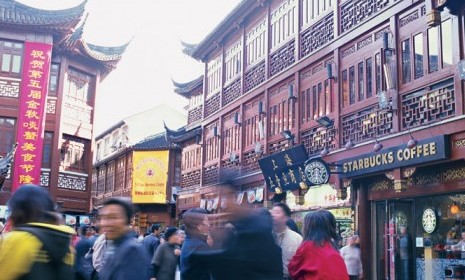
- Select a language for the TTS:
- UK English Female
- UK English Male
- US English Female
- US English Male
- Australian Female
- Australian Male
- Language selected: (auto detect) - EN
Play all audios:
Starbucks yesterday announced ambitious plans to expand into mainland China by 2015. The decision comes less than two years after the coffee giant closed hundreds of U.S. locations, citing
the recession and "store oversaturation." Since then, "the company has turned around its U.S. business," says Angela Moore at _MarketWatch_, but it should be careful with
its "aggressive expansion in China" and "heed lessons from recent years." (Watch CEO Howard Schultz discuss the move.) Here, a brief guide to Starbucks' China
gambit, by the numbers: AT LEAST 1,500 Number of stores that Starbucks wants to be operating in mainland China by 2015, tripling its current tally SUBSCRIBE TO THE WEEK Escape your echo
chamber. Get the facts behind the news, plus analysis from multiple perspectives. SUBSCRIBE & SAVE SIGN UP FOR THE WEEK'S FREE NEWSLETTERS From our morning news briefing to a weekly
Good News Newsletter, get the best of The Week delivered directly to your inbox. From our morning news briefing to a weekly Good News Newsletter, get the best of The Week delivered directly
to your inbox. MORE THAN 16,000 Current number of Starbucks locations around the world 600 Number of U.S. Starbucks outlets that the company closed in 2008 A free daily email with the
biggest news stories of the day – and the best features from TheWeek.com ABOUT 200 Number of U.S. outlets Starbucks closed in 2009 $145 BILLION Size of the world's coffee market $945.6
MILLION Starbucks' net profit for fiscal 2010 200 MILLION Approximate size of China's middle-class population. "In the next decades, the population of China's
middle-class and affluent consumers, whose annual household incomes exceed 60,000 yuan ($9,016) will nearly triple," says Carol Liao, a business consultant, as quoted in the
_International Business Times_. 150,000 Number of Beijing residents who are worth more than $1.5 million $2,025/YEAR OR $5.50/DAY The average income in China. It's still a
"relatively poor country" says Brook Larmer in the _New York Times_, and "the wealth from China's sustained economic boom is highly concentrated." But, this year it
overtook the U.S. to become the world's second largest consumer of luxury goods, "trailing only — for the moment — Japan." $1.40/DAY Average food expenditure per person in
China $3.63 Price of a 16-ounce Starbucks latte in China. Thus far, "Starbucks has done well in China partly because of its snob appeal," say Max Magni and Yuval Atsmon in the
_Harvard Business Review_. Sources: _Seattle Pi_, _Huffington Post_, ___USA Today__,_ _New York Times_ (2), _CNBC_, _Bloomberg_, _Harvard Business Review,_ ___International Business Times_








